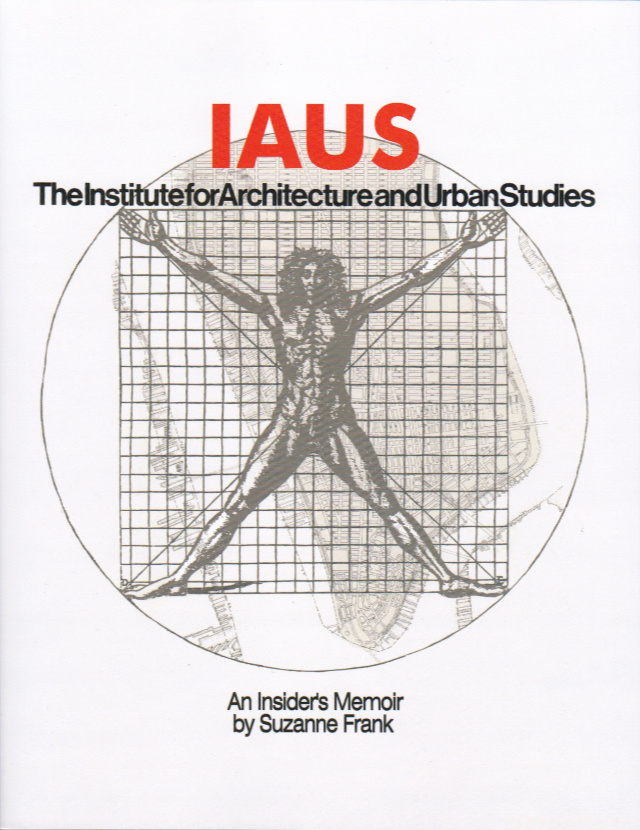IAUS
IAUS: An Insider's MemoirSuzanne FrankAuthorHouse, November 2010Paperback | 8-1/2 x 11 inches | 364 pages | English | ISBN: 978-1452086965 | $85.99PUBLISHER'S DESCRIPTION: The book is a combined memoir and impressionistic history of the Institute for Architecture and Urban Studies. At first affiliated with New York’s Museum of Modern Art and Cornell University, the Institute housed architects, artists and historians who worked on creative design and intellectual projects and would become world renown. Its creation and direction was in the hands of its able leader, Peter Eisenman. Besides a documentary study of the work that went on there, among an international clearing house, the book is laced with impressions of the author’s experience there. It has been in the works for over 12 years and was originally financed by the Graham Foundation for the Study of the Fine Arts and has subsequently been aided by Dr. Jenny Kaufmann. The photographs of the Institute at the height of its activity are included and so does an original ground plan of its West 40th Street office done by Scott Brandi who also designed the book. It ends with 27 interviews of prominent members of the Institute who comment on it and their experiences. The book should appeal to architecture students and those interested in architecture and urbanism of the seventies when the government in the United States was more reasonable in economic and political equity. Suzanne Frank has a Ph.D. in art history (1970) and has concentrated on architecture and urban history for the last 40 years. Graduating from the Art History and Archaeology Department at Columbia University, she has researched and written about American and European architecture with an emphasis on the 19th and 20th centuries. ... In 1994 she published a book on her house in Cornwall Connecticut by Peter Eisenman. ... Her stint at the Institute for Architecture and Urban Studies began in February 1970 while she was made a fellow in 1977. REFERRAL LINKS: dDAB COMMENTARY: The coronavirus pandemic has forced most previously in-person events to take place online. While it's easy to register for a lecture and then hop on Zoom to watch it, I'll admit that staring at my computer screen for a couple hours, after a day spent doing basically the same, is not appealing, leading me to pass on talks I might have gone to in person otherwise. One day — it helped that it was during the day and not in the evening — I made an exception and watched the 2013 documentary The Making of an Avant-Garde: The Institute for Architecture and Urban Studies 1967-1984, which was directed by Diana Agrest and was followed by a discussion. As the subtitle makes clear, the doc tells the story of the Institute for Architecture and Urban Studies (IAUS), where Agrest was a fellow for most of its short life, from 1972 to 1984. In the discussion she was joined by Kim Förster, who received a grant from the Graham Foundation in 2013 for the still-forthcoming The Institute for Architecture and Urban Studies, New York, 1967–1985: Networks of Cultural Production, and Christophe Van Gerrewey, whose books, including OMA/Rem Koolhaas: A Critical Reader, focus on history, theory, and their articulation in texts. I enjoyed the film, more for its historical information than its congratulatory tone, and, to a lesser degree, the discussion as well, which was open to questions from people participating via Zoom. One outcome of the virtual event for me was purchasing IAUS: An Insider's Memoir by Suzanne Frank, an IAUS fellow who is familiarly known to architects as the client of Peter Eisenman's House VI, which was built in Cornwall, Connecticut, in 1975. (She wrote Peter Eisenman's House VI: The Client's Response about twenty years after the house was done.) Until Förster's academic history of the IAUS is finally published, Frank's "insider's memoir" is the only book-length treatment of the influential non-academic institution that presented lectures, published books and a journal, printed a newsletter, hosted exhibitions, functioned as a school, and was directly responsible for at least one building. Billed as a "combined memoir and impressionistic history" of the IAUS, the book touches on all these elements of its output, while also including transcripts of interviews with many key players — 27 of them, but not Eisenman, who founded the institute and was its guiding force but "won't be be interviewed on the Institute at all," per Frank's acknowledgments. Even though, like Förster, Frank supposedly received a Graham Foundation grant for her research, in 1998, the book was not (self-)published until 2011. (People interested in buying the book should do so directly from AuthorHouse, where the price is currently 50% off the ridiculously high cover price.) IAUS: An Insider's Memoir uses the output of the Institute to structure its seven chapters. Following the first chapter, which breezes through IAUS's chronological history, are indi

AuthorHouse, November 2010
Paperback | 8-1/2 x 11 inches | 364 pages | English | ISBN: 978-1452086965 | $85.99
PUBLISHER'S DESCRIPTION:
REFERRAL LINKS:
SPREADS:









